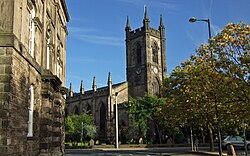Stoke-upon-Trent
| Stoke-upon-Trent | |
| Staffordshire | |
|---|---|
 Stoke Minster | |
| Location | |
| Grid reference: | SJ875455 |
| Location: | 53°0’24"N, 2°11’16"W |
| Data | |
| Post town: | Stoke-on-Trent |
| Postcode: | ST4 |
| Dialling code: | 01782 |
| Local Government | |
| Council: | Stoke-on-Trent |
| Parliamentary constituency: |
Stoke-on-Trent Central |
Stoke-upon-Trent, commonly called Stoke or Stoke town, is a component town of the city of Stoke-on-Trent in Staffordshire. Of the Six Towns, it stands in the centre, between Hanley and Fenton
Stoke-upon-Trent is the seat of the city council of Stoke-on-Trent, though it has been surpassed by Hanley as the commercial centre of the combined city.
Name
At the time of the federation of the Six Towns in 1910, Stoke's name was chosen as the basis for that of the whole new borough as the centre its administration, and the centre of transport links. Stoke too has the oldest, most recognised name, and the name of the mainline railway station.
Stoke might have been expected to become the dominant town of the six by virtue of its transport connections, but this was not to be. Some confusion can therefore now arise form the similarity of the town's name with that of the larger conurbation.
Certain business leaders have and academics have proposed that Stoke-upon-Trent be renamed, or that the wider conurbation be renamed, to avoid the clash of names. Proposals for Stoke have the included "Old Stoke", "Stoke Minster" and "Stoke Town". At the same time, some businesses in Hanley have sought to redesignate that town as "Stoke-on-Trent City Centre".
Growth of Stoke and its transport links
Stoke was located where the young River Trent meets the Fowlea Brook. The later Roman road through Stoke remained the basis for local road transport long after the Roman occupation.
The Old English name given to this ancient place was 'stoc', meaning little more than "place". It was the site of the first church in the area, built of wood around the year 670 by missionaries from Lindisfarne, later rebuilt in stone, and now known as Stoke Minster.[1] A significant small town grew up around this church.
In the 18th Century, the "Grand Trunk" canal came along the Trent valley to carry china clay from Cornwall cheaply to the Potteries (and pottery safely away). Many of the promoters of the canal were pottery magnates.
In the 19th century, the railways, too, came along the valley. The mainline Stoke-on-Trent railway station was opened by the North Staffordshire Railway (NSR) on 9 October 1848, replacing the temporary station sited at Whieldon road, which was constructed for the opening of the first NSR line on 17 April 1848. Travellers to the region would change trains at Stoke for local trains to their ticketed destination.
Churches in Stoke-upon-Trent
- Church of England: Stoke Minster (St Peter Ad Vincula)
King's Hall
The assembly hall, ballroom, exhibition hall and theatre built in 1910–11 at the time of the federation to the design of T. Wallis and J.A. Bowater and with an impressive 19-bay dressed stone frontage on Kingsway behind the Town Hall. It has proved itself to be a useful adjunct to the Town Hall of 1834–50. This was built on Glebe Street, opposite the parish church to the design of Henry Ward.[2] The entire Town Hall–King's Hall complex serves the city of Stoke-on-Trent well as its chief administrative offices, including the Lord Mayor's Parlour combined with all the facilities of the King's Hall for the city's formal entertainment.
The Potteries
In the 19th century, Stoke had a thriving pottery industry, hence its nickname, "The Potteries". Since the last half of the 20th century, however, almost all of the bottle-shaped kilns have been taken down, due to regulations from the Clean Air Act — an estimated 4,000 bottle kilns in the heyday of the pottery industry, today reduced to a mere 46.
Stoke today
Although Stoke is surpassed by its neighbouring town, Hanley in terms of size, population, and shops, it does have:
- Stoke Minster[1]
- the same (abbreviated) name as the City
- the mainline railway station
- the main campus of Staffordshire University, its library and halls of residence (these are actually located on land that was originally part of Hanley) and was the original site of the Staffordshire Cricket Clubs ground.
- a long-established purpose-built art house cinema, The film Theatre.
- a purpose-built repertory theatre[1]
- the Irish centre
- the Trent and Mersey canal and its National Cycle Network long-distance bicycle paths (NCN Route 5)
- the main complex of Council offices & chamber - clustered in and around the Town Hall
- the Minster church and Stoke Approach area and the outdoor artworks
- The King's Hall music & events venue
- a free public lending library
- The Spode Copeland pottery factory, disused since 2008 but in August 2010 at the start of a £25m regeneration programme.
- The Villas, the first conservation area in Stoke, containing several Grade II listed houses
- The University Hospital of North Staffordshire and the City General Hospital, as well as the Central Outpatients Department, is nearby. This is one, if not the, largest hospitals in the UK.
Outlying townships or districts within the bounds of Stoke-upon-Trent include Boothen, Hartshill, Mount Pleasant, Penkhull and Trent Vale.
References
- ↑ 1.0 1.1 "Stoke Minster website". http://www.stokeminster.com.
- ↑ Pevsner, Nikolaus (1974). The Buildings of England - Staffordshire. Penguin Books. p. 262. ISBN 0140710469.